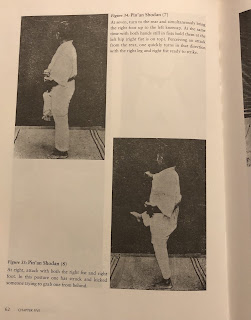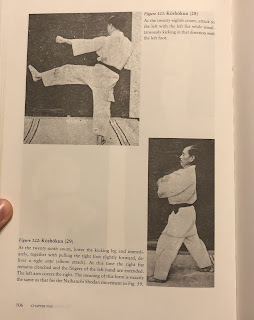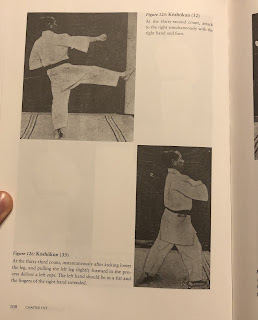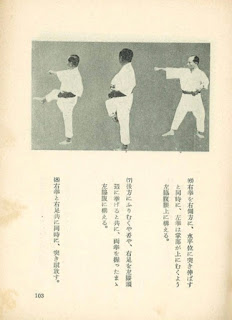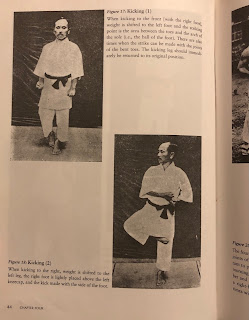Uechi-ryu Karate Illustrating a Sword-foot Kick
Gichin Funakoshi Demonstrating Keriage in Rentan Goshin Karate Jutsu (Karate Jutsu)
Gichin Funakoshi Performing Keriage, Illustrated in Karate Jotatsu Ho, by Yasuhiro Konishi (1956)
Gichin Funakoshi Specifically Noting Using the Sword-foot in Rentan Goshin Karate Jutsu (Karate Jutsu)
Gichin Funakoshi’s keriage (keage / rising kick / side rising-kick / side snap-kick / side-up kick) was different to the modern version usually seen. In an article for Black Belt Magazine, Tsutomu Ohshima, a student under Gichin Funakoshi, stated that he had asked Isao Obata, his senior, about the side-up kick, to which Obata replied by enquiring as to if Ohshima had seen the way their teacher, Funakoshi, had performed it. That is how Obata had continued to practise it, and Ohshima realised that it was a better way physiologically.
“For a long time there was confusion about the right way to perform the side-up kick. When Master Funakoshi was showing us how to do it, he just made a small, low motion with his foot, exactly like the front snap kick except with the body facing to the side. Many of us assumed he did the kick that way because he was old. At that time, we thought the side-up kick should be delivered higher, with the knee turned in, which looked fancier but was harder to do. That was the way I practiced it when I came to the United States.
“I practiced that way for many years, but I began to develop problems with my back. Finally Senior Obata, the first captain of the Keio University karate club, was visiting this country (at my invitation) and I mentioned this to him. I said, “You know, I think there is something wrong with the side-up kick. If you perform it this way, it is very bad for the back.” Obata said, “Of course. That’s not the way to do the side-up kick. Didn’t you see how the Master did it?” Master Funakoshi was showing us the right way all along, but we didn’t understand what was wrong with our own way until many years later.”
(Black Belt Magazine, March 1982)

